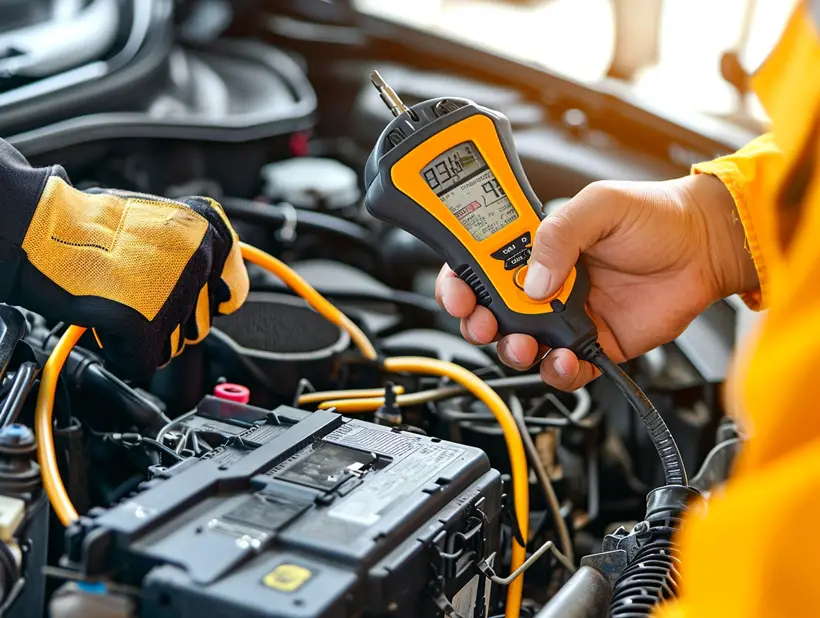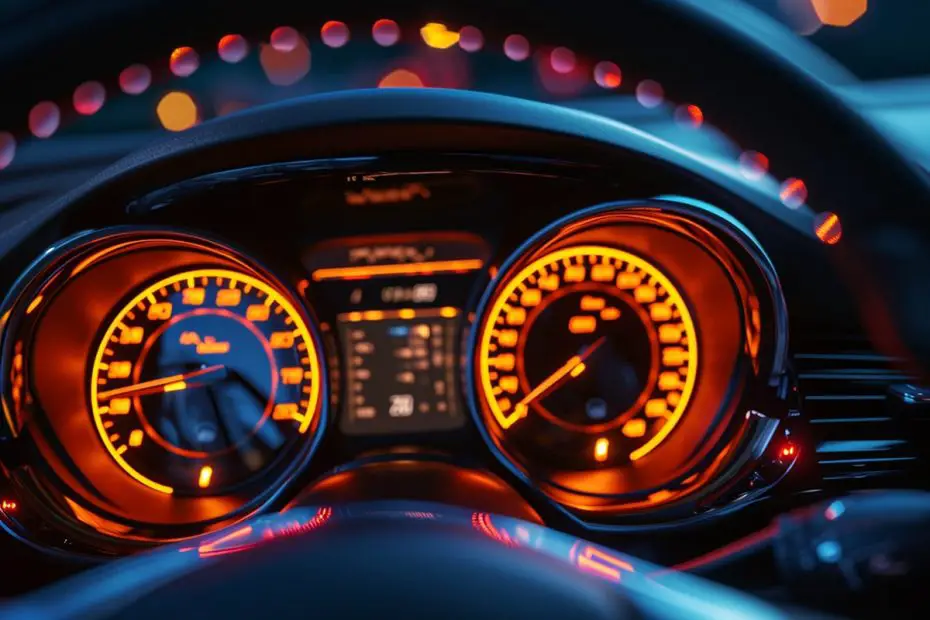If you’ve ever been driving and suddenly noticed that your ABS light has come on, you’re not alone. It’s a situation that many of us have found ourselves in, and it can be quite unsettling. But fear not, because in this article, we’re going to guide you through what to do when your ABS light illuminates.
First things first, it’s important to understand what the ABS light actually means. ABS stands for Anti-lock Braking System, and when the light comes on, it’s an indication that there may be an issue with this system in your vehicle. While it’s always best to consult a professional mechanic, we’ll provide you with some initial steps you can take to address the situation and ensure your safety on the road.
So, if you’re ready to tackle the ABS light issue head-on, let’s dive in and explore the steps you can take when this warning light illuminates.
Understanding the ABS Light
The ABS light in your vehicle serves as an important warning indicator. When it illuminates on your dashboard, it’s crucial to understand what it means and the actions you should take. In this section, we will delve into the details of the ABS light and its significance in ensuring your safety on the road.
What does the ABS light indicate?
The ABS light stands for Anti-lock Braking System. When it comes on, it indicates a potential issue with this important system in your vehicle. The ABS system is designed to prevent your wheels from locking up during braking, allowing for better control and stability while stopping. So, when the light illuminates, it’s a sign that there may be a problem with this essential safety feature.

Why is it important to address the ABS light?
Addressing the ABS light is crucial because it directly affects your braking system. Ignoring this warning light could compromise your ability to brake safely, especially in emergency situations. Additionally, the ABS light can also indicate other underlying issues with your vehicle’s braking system, such as a faulty sensor or a malfunctioning ABS module. By addressing the ABS light promptly, you can prevent further damage and potential safety hazards on the road.
What should you do when the ABS light illuminates?
When the ABS light comes on, it’s important not to panic. Instead, follow these steps to address the issue and ensure your safety:
- Check your brake fluid level: Low brake fluid can trigger the ABS light. Check your vehicle’s owner manual to locate the brake fluid reservoir and inspect the level. If it’s low, top it up with the recommended brake fluid.
- Inspect your brake pads and rotors: Worn-out brake pads or damaged rotors can also activate the ABS light. Check the condition of your brake pads and rotors and replace them if necessary.
- Check your ABS sensors: Faulty ABS sensors can cause the ABS light to come on. Inspect the sensors for any visible damage or debris that may be blocking their proper functioning. If needed, clean or replace the sensors accordingly.
- Consult a professional mechanic: If you’ve followed these steps and the ABS light is still illuminated, it’s advisable to consult a professional mechanic. They have the expertise and specialized equipment to diagnose and fix any underlying issues with your ABS system.
Common Causes of the ABS Light Illuminating

When the ABS light illuminates in your vehicle, it’s important to understand the possible causes. Here are some common reasons why the ABS light may come on:
- Low Brake Fluid Level: Insufficient brake fluid can trigger the ABS light. Check the brake fluid reservoir and ensure it is at the correct level. If it’s low, add the appropriate brake fluid recommended by the manufacturer.
- Worn Brake Pads or Rotors: If your brake pads or rotors are worn down, it can affect the ABS system and cause the light to illuminate. Regularly inspect your brake pads and rotors for signs of wear and replace them if necessary.
- Malfunctioning ABS Sensors: The ABS system relies on sensors to detect wheel speed and prevent wheel lock-up. If these sensors become damaged or fail, the ABS light may turn on. A professional mechanic can perform a diagnostic scan to identify and replace any faulty ABS sensors.
- Faulty ABS Control Module: The ABS control module is the brain of the system, responsible for interpreting data from the sensors and activating the ABS when necessary. If the control module malfunctions, it can cause the ABS light to come on. A qualified technician can diagnose and repair or replace the faulty control module.
- Electrical Issues: Various electrical problems, such as damaged wiring or a blown fuse, can disrupt the proper functioning of the ABS system. It’s important to have a professional technician check the electrical connections and perform a thorough inspection to identify and fix any electrical issues.
Remember, if the ABS light illuminates in your vehicle, it signifies a potential problem with the Anti-lock Braking System. While these are some common causes, it’s essential to address the issue promptly to ensure your safety and the proper functioning of your vehicle’s braking system. If the ABS light remains illuminated after checking these common causes, it’s recommended to consult a professional mechanic for further assistance.
Step 1: Check the Brake Fluid Level
When the ABS light illuminates in your vehicle, the first step you should take is to check the brake fluid level. The brake fluid plays a crucial role in the proper functioning of the braking system, including the ABS. A low brake fluid level can trigger the ABS light to come on.
Here’s how you can check the brake fluid level on your own:
- Locate the brake fluid reservoir in the engine compartment. It is usually located near the firewall on the driver’s side.
- Remove the cap of the brake fluid reservoir.
- Inspect the fluid level. The reservoir will have minimum and maximum marks. The fluid should be between these marks.
- If the fluid is below the minimum mark, top it up using the recommended brake fluid specified in your vehicle’s owner’s manual.
- Replace the cap securely.

If the brake fluid level is low, it could indicate a leak in the brake system. In this case, it’s important to have your vehicle inspected by a professional mechanic. A brake fluid leak can affect the overall performance of your braking system, compromising your safety on the road.
Regularly checking the brake fluid level is a good practice to ensure the proper functioning of your vehicle’s braking system, including the ABS. If the ABS light illuminates due to a low brake fluid level, addressing this issue promptly can help avoid further complications with your braking system.
So, make it a habit to check your brake fluid level as part of your regular vehicle maintenance routine. Remember, your safety and the safety of others on the road depend on properly functioning brakes.
Here are some statistics related to the importance of proper brake fluid level:
| Statistic | Fact |
|---|---|
| 1 in every 4 accidents are caused by brake failure. | Ensuring proper brake fluid level can help prevent accidents. |
| 63% of drivers don’t check their brake fluid level regularly. | Regular maintenance of brake fluid is crucial. |
| Over 40% of vehicles on the road have low brake fluid levels. | Low brake fluid levels are a common issue. |
Step 2: Inspect the Wheel Speed Sensors
When the ABS light illuminates in your vehicle, it’s important to take the necessary steps to diagnose and address the issue. One potential culprit for the ABS light coming on is a problem with the wheel speed sensors. These sensors play a crucial role in monitoring the rotational speed of each wheel and helping the ABS system prevent wheel lock-up during braking.
To inspect the wheel speed sensors, follow these steps:
- Locate the wheel speed sensors: The sensors are typically located near the wheels, either on the wheel hub or on the brake caliper. Refer to your vehicle’s manual for the exact location.
- Visually inspect the sensors: Check for any visible damage or signs of wear on the sensors. Look for loose or frayed wires, corrosion, or dirt build-up that could interfere with their functioning. If you notice any problems, repairs or replacements may be necessary.
- Test the sensors: Use a multimeter to test the continuity and resistance of the sensors. Follow the instructions in your vehicle’s manual for the correct procedure. If the sensors fail the test, they may need to be replaced.
- Clean the sensors: If there are no visible issues and the sensors pass the test, cleaning them may improve their performance. Use an electronic parts cleaner or brake cleaner to remove any dirt or debris. Be gentle and avoid damaging the sensors.
- Reinstall and retest: Once you have completed the inspection and any necessary repairs or cleaning, reinstall the sensors and test your vehicle to see if the ABS light has turned off. If it hasn’t, further diagnostics may be needed.
Remember, the wheel speed sensors are crucial components of the ABS system, and any issues with them can affect the performance of your brakes. If you’re not confident in inspecting or repairing the sensors yourself, it’s always best to consult a professional mechanic.
By taking the time to inspect the wheel speed sensors, you’ll be one step closer to identifying and resolving the issue behind your ABS light illuminating. Let’s proceed to the next step to continue troubleshooting the problem.
Step 3: Examine the ABS Module
When the ABS light illuminates on your vehicle, it’s crucial to take immediate action to ensure your safety on the road. In this step, we will guide you through examining the ABS module to further troubleshoot the issue.

What is the ABS Module?
The ABS module, also known as the ABS control unit or ABS pump, is a vital component of your vehicle’s anti-lock braking system. Its main function is to control and regulate the pressure in the brake lines to prevent wheel lock-up during sudden braking, improving overall braking performance and stability.
- Locate the ABS Module: The ABS module is typically located near the master cylinder or firewall in the engine compartment. Refer to your vehicle’s manual for the exact location.
- Inspect for Physical Damage: Carefully examine the ABS module for any signs of physical damage, such as corrosion, leaks, or loose connections. Any noticeable issues should be addressed promptly.
- Check the Wiring and Connectors: Inspect the wiring harness and connectors connected to the ABS module. Look for loose or damaged wires, frayed insulation, or any other irregularities. Ensure that all connections are secure.
- Verify Power Supply: Use a multimeter to test the power supply to the ABS module. Ensure that there is proper voltage reaching the module and that the fuses related to the ABS system are intact.
- Scan for Error Codes: Use an OBD-II scanner or ABS-specific diagnostic tool to retrieve any error codes related to the ABS module. These codes will provide valuable information about the specific issue at hand.
- Consult a Professional: If you are unsure about any of the steps or encounter complex issues during the examination, we recommend consulting a professional mechanic. They have the expertise and specialized equipment to accurately diagnose and repair ABS module problems.
By examining the ABS module, you are taking a proactive approach to identify any potential issues with your vehicle’s ABS system. Remember that regular maintenance and prompt repairs are key to ensuring the optimal functioning of your brakes and overall vehicle safety.
| Important Points |
|---|
| – The ABS module is responsible for regulating brake pressure to prevent wheel lock-up. |
| – Inspect the ABS module for physical damage, loose connections, and wiring issues. |
| – Test the power supply to the module and scan for error codes using diagnostic tools. |
Step 4: Test the ABS Pump and Accumulator
When troubleshooting the ABS light issue in your vehicle, it is important to thoroughly test the ABS pump and accumulator. These components play a critical role in the proper functioning of the ABS system.
Inspect the ABS Pump and Accumulator
- Locate the ABS pump and accumulator: The ABS pump and accumulator are typically located near the master cylinder or on the firewall of the vehicle’s engine compartment. Refer to your vehicle’s manual for the exact location.
- Check for physical damage: Examine the ABS pump and accumulator for any signs of physical damage, such as leaks, cracks, or loose connections. Any damage could compromise the effectiveness of the ABS system and should be addressed promptly.
- Inspect the wiring and connectors: Carefully inspect the wiring and connectors connected to the ABS pump and accumulator. Look for any loose or corroded connections and ensure that the wiring is free from damage or wear. Faulty wiring or connectors can cause the ABS light to illuminate.
- Verify the power supply: Ensure that the ABS pump and accumulator are receiving a proper power supply. Use a multimeter to check the voltage at the connectors. The voltage should match the specifications provided in your vehicle’s manual. If the voltage is incorrect, there may be an issue with the power supply that needs to be addressed.
- Perform a self-diagnostic test: Many vehicles with ABS systems have the capability to perform a self-diagnostic test. Refer to your vehicle’s manual for instructions on how to initiate this test. The self-diagnostic test will check the functionality of the ABS pump and accumulator and provide any necessary error codes.
- Scan for error codes: If your vehicle does not have a self-diagnostic test feature, you can still scan for error codes using an OBD-II scanner. Connect the scanner to the OBD-II port, typically located under the dashboard, and follow the instructions provided with the scanner. The scanner will read any error codes stored in the ABS module, allowing you to pinpoint the exact issue.
Regular maintenance and prompt repairs are crucial for the optimal functioning of your vehicle’s braking system. By testing the ABS pump and accumulator, you can identify any potential issues and take the necessary steps to resolve them, ensuring the safety of both you and your vehicle on the road.
Step 5: Verify Brake Fluid Levels and Quality

When the ABS light illuminates in your vehicle, it’s important to go through a systematic troubleshooting process to identify the underlying issue. In this step, we will guide you on how to check the ABS fuse, which is a critical component of the ABS system.
Why is the ABS fuse important?
The ABS fuse is responsible for protecting the ABS module and other electrical components of the ABS system from power surges and short circuits. If the fuse is blown or faulty, it can cause the ABS light to come on and affect the overall functioning of the ABS system.
Here’s how you can check the ABS fuse:
Step 1: Locate the fuse box
- Consult your vehicle’s owner’s manual to find the location of the fuse box. It is typically located either under the dashboard or in the engine compartment.
- Once you have located the fuse box, use a flashlight if needed to get a better view of the fuses.
Step 2: Identify the ABS fuse
- Refer to the fuse box diagram in your owner’s manual to locate the specific fuse for the ABS system. The diagram will outline the fuse number and its corresponding location in the fuse box.
- In some cases, the ABS fuse may be labeled as “ABS” or “Anti-Lock Brakes.” However, if it’s not clearly labeled, you can refer to the owner’s manual for further guidance.
Step 3: Inspect the ABS fuse
- Carefully remove the ABS fuse from the fuse box using a pair of needle-nose pliers.
- Inspect the fuse for any signs of damage, such as a blown or melted fuse element. If you notice any damage, replace the fuse with a new one of the same amperage rating.
Step 4: Test the ABS system
- After replacing the fuse, turn on the ignition and check if the ABS light has turned off. If it has, it indicates that the blown fuse was the cause of the ABS light illumination.
- Take your vehicle for a test drive to ensure that the ABS system is functioning properly. Pay attention to any warning lights or unusual noises during the test drive.
Remember, if the ABS light continues to illuminate after checking and replacing the fuse, further inspection and diagnosis may be necessary. It’s always recommended to consult a qualified mechanic or technician to ensure accurate diagnosis and repairs.
Conclusion
Taking immediate action when your ABS light illuminates is crucial for ensuring the safety of your vehicle and its occupants. Our step-by-step guide has provided you with the necessary information to troubleshoot and address the issue. By checking the ABS fuse, you can protect the ABS module and other electrical components of the ABS system.
Remember to regularly inspect the ABS fuse for any signs of damage and replace it if necessary. Testing the ABS system after replacing the fuse is essential to ensure proper functioning. If the ABS light continues to illuminate, it’s important to consult a qualified mechanic for further diagnosis and repairs.
Maintaining your vehicle’s brakes is vital for optimal performance and overall safety. By following our guide and seeking professional assistance when needed, you can address ABS light issues promptly and keep your vehicle in top condition.
Don’t ignore the ABS light – take action today and drive with confidence knowing that your vehicle’s braking system is functioning properly.
